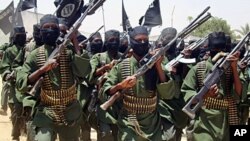The Somali insurgent group al-Shabab announced a surprise withdrawal from Mogadishu August 6, clearing the way for government and international forces to retake the city. But an analyst warns the fight for southern Somalia is far from over.
For the first time in nearly five years, the Somali capital is in the hands of the country’s embattled Transitional Federal Government. Saturday, the TFG began to quickly move its forces - along with African Union peacekeepers - into the void left by Islamist insurgent group al-Shabab.
Al-Shabab had occupied most of the capital from its inception in 2007, putting block after block under its control and backing the U.N.-backed government into small section of the city. With the situation at its bleakest just over one year ago, government troops and soldiers from the AU force AMISOM began to battle back, steadily retaking territory.
In July, government troops closed in on the sprawling Bakara market, perhaps the most important position held by the rebels in the war-torn city.
Al-Shabab spokesman Mohamed Ali Rage suddenly announced on local radio Saturday that the group would leave Mogadishu entirely, in order to regroup and change tactics. The announcement was greeted with jubilation on the ground and hailed as a major achievement by the international community.
But Rage warned that al-Shabab would return. Rashid Abdi, an analyst for the Brussels-based International Crisis Group, warns observers not to heap praise on the TFG too quickly.
“This is symptomatic of the fact that al-Shabab is now a disintegrating movement," Abdi said. "It is clear that no one knows who is now in charge. And I think the picture is much more complicated.”
For Abdi, part of the worry about Rage’s announcement involves questions surrounding Rage himself. Al-Shabab has publicly divided over the past year into competing factions - with yet another group of foreign fighters also exercising influence over the leadership. Last year, the group merged with separate rebel group Hizbul Islam, further complicating the question of command. It is not clear whether Rage remains in good standing with one or all of al-Shabab’s many factions.
While a fractured and divided enemy sounds like a victory, Abdi says it will make confronting what remains of al-Shabab even more difficult.
“It was even complicated for AMISOM and the TFG to deal with al-Shabab when it was a more cohesive organization," Abdi said. "I am not sure that it will now be easier to deal with a movement that is disintegrated to so many splinter factions.”
Al-Shabab has not totally vacated the capital. There have been reports of fighting between the African Union force AMISOM and vestiges of al-Shabab, illustrating perhaps that not all the fighters are under the same command.
Even with the fighting, AMISOM says nearly 90 percent of the city is now under its control, compared with less than half just under a year ago. But with the added control comes the constant problem of security and stability. AMISOM has itself estimated it needs around 20,000 troops to securely control Mogadishu, but now has around 9,000. Although some suggest the government troops may be able to fill this void, Abdi - and many analysts - are skeptical.
“The reality is that the government will not be able to prosecute this counterinsurgency struggle unaided by AMISOM. I think that will remain the case for the next few years. I don’t see the TFG security forces being able to take on the challenge of security in Mogadishu,” Abdi said.
Reports in Somalia indicated that President Sheikh Sharif Sheikh Ahmed has already flown to Uganda and Burundi - the two main contributors to the AMISOM force - to request an additional 3,000 troops.
The other looming challenge is to finally destroy al-Shabab once and for all. While Mogadishu was al-Shabab's most prominent conquest, the group still controls much of southern and central Somalia and maintains most of its organizational capacity in the Jubba region.
“The bulk of al-Shabab’s firepower in southern Somalia is in the Jubba territory," Abdi said. "And I think once Mogadishu reverts back into government hands then I think the bigger challenge will be how to deal with the southern regions.”
Abdi says if AMISOM troops are forced to fan out from Mogadishu, they will greatly limit their effectiveness, with or without the infusion of 3,000 additional troops.
For now, the withdrawal of al-Shabab is a landmark in the seven years of the TFG’s existence. The insurgents' retreat from Mogadishu will allow humanitarian groups to greatly expand operations and address the ongoing famine affecting millions in the country. But it is unclear how long the window will remain open before the fight for Somalia continues.
Analyst Warns al-Shabab Retreat is Not Victory











